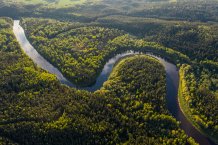articles

Average rainfall in the Amazon has not changed dramatically in recent decades, but dry seasons have become longer
Amazon rainforest losing resilience
The Amazon rainforest is becoming less resilient – raising the risk of widespread dieback, new research shows.
The study found that resilience – the ability to recover from events such as droughts or fires – has declined consistently in more than three quarters of the rainforest since the early 2000s.
Experts believe the Amazon could soon reach a tipping point, crossing of which would trigger dieback and turn much of the forest to savannah, with major impacts on biodiversity, global carbon storage and climate change.
It is not clear when that critical point could be reached, but the study says the loss of resilience is "consistent" with an approaching tipping point.
The research was carried out by the University of Exeter, the Potsdam Institute for Climate Impact Research (PIK) and Technical University of Munich. Exeter and PIK recently signed an agreement to jointly investigate climate change tipping points.
"The Amazon rainforest is a highly complex system, so it's very difficult to predict if and when a tipping point could be reached," said Dr Chris Boulton, of Exeter's Global Systems Institute.
"We now have satellite data on the Amazon that covers a sufficiently long timespan to observe changes in resilience.
"Our study looked in detail at month-to-month changes as the forest responded to fluctuating weather conditions.
"We studied metrics that are theoretically related to the rate of recovery after perturbations (external events that affect the forest), to see how the resilience of the Amazon ecosystem has changed in recent decades.
"Resilience dropped during the major droughts of 2005 and 2010, as part of an ongoing decline from the early 2000s to the most recent data in 2016.
"As a result, we would expect the forest to recover more slowly from a drought now than it would have twenty years ago."
Resilience actually increased from 1991 to around 2000, but the consistent decrease since then has taken resilience well below 1991 levels.
"Deforestation and climate change are likely to be the main drivers of this decline," said Professor Niklas Boers, of PIK and the Technical University of Munich.
"Resilience is being lost faster in parts of the rainforest that are closer to human activity, as well as those with less rainfall.
"Many researchers have theorised that a tipping point could be reached, but our study provides vital empirical evidence that we are approaching that threshold."
The study used various data sources, including satellite data on Vegetation Optical Depth (VOD) – a measure of the total biomass of trees and other plants in a given area.
Despite climate change, average rainfall in the Amazon has not changed dramatically in recent decades.
However, dry seasons have become longer and droughts have become more common and more severe.
The study's VOD measurements suggest overall biomass has declined slightly, but the loss of resilience is much more pronounced.
The researchers emphasise this distinction between resilience and the average "state" of the rainforest.
"The rainforest can look more or less the same, yet it can be losing resilience – making it slower to recover from a major event like a drought," explained Professor Tim Lenton, Director of Exeter’s Global Systems Institute.
"If too much resilience is lost, dieback may become inevitable – but that won't become obvious until the major event that tips the system over," said Professor Boers.
"Many interlinked factors – including droughts, fires, deforestation, degradation and climate change – could combine to reduce resilience and trigger the crossing of a tipping point in the Amazon."
Professor Lenton added: "This gives new compelling evidence to support efforts to reverse deforestation and degradation of the Amazon to give it back some resilience against ongoing climate change."
The research is part of the project “Tipping Points in the Earth System” funded by European Union’s Horizon 2020 programme, and received additional funding from the Leverhulme Trust and the Alan Turing Institute.
The paper, published in the journal Nature Climate Change, is entitled: "Pronounced loss of Amazon rainforest resilience since the early 2000s."
Date: 7 March 2022
